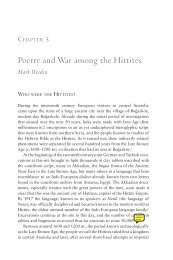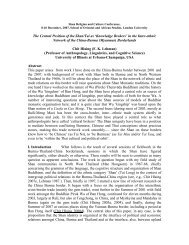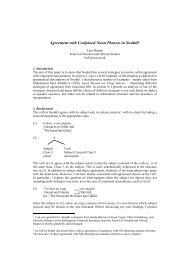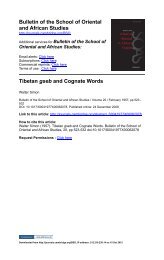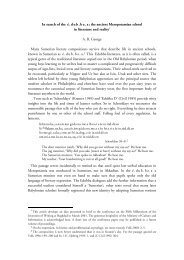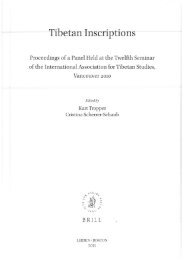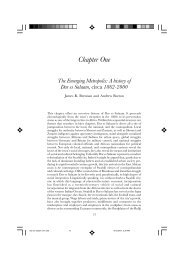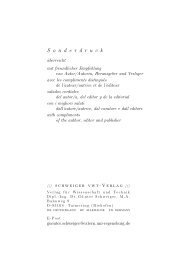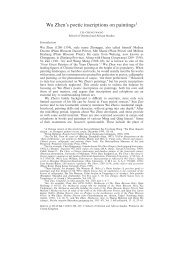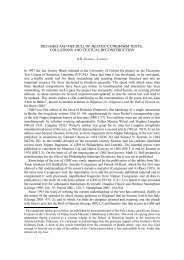000_JLC3_debut_FL - SOAS Research Online
000_JLC3_debut_FL - SOAS Research Online
000_JLC3_debut_FL - SOAS Research Online
Create successful ePaper yourself
Turn your PDF publications into a flip-book with our unique Google optimized e-Paper software.
22 G. Tucker Childs<br />
There were basically two phases to what has been called the Mande Expansion, the first<br />
peaceful and gradual, the second more warlike and concentrated (Brooks 1993). 6 In the first<br />
phase, Mande penetration of western Africa was characterized by a lengthy period of peaceful<br />
trade and settlement beginning in the early centuries of the Common Era (Niane 1989). The<br />
first phase comprised a steady influx of smiths and traders, the former obtaining power<br />
through their control of secret societies, the latter through their control of commerce and<br />
external contacts. The Mande generally did not assimilate to the Atlantic people among whom<br />
they settled and took wives, but maintained a separate identity. In the north, for example,<br />
Mandinka traditions concerning the Fati and Sane families, two Mande clans long<br />
involved in commerce, relate how members [settled along and south of the Gambia<br />
River] during the c.1100-c.1500 dry period with both groups reportedly settled<br />
peacefully among their [Atlantic] hosts, yet at the same time retaining their Mande<br />
linguistic, social, and cultural attributes (Brooks 1993:67).<br />
The second phase is characterized below:<br />
… an era of conquest and state building by Mandekan [Mandeng] warriors that<br />
began during the [fifteenth century] … The second featured the Mandekan (horse)<br />
warriors, who achieved their control in western Africa strictly through physical<br />
force and collaboration with the Mande traders and smiths already in place. The<br />
second change brought far-reaching changes to western African peoples (Brooks<br />
1993:59).<br />
In the north more than in the south there are histories of major polities clashing, although<br />
there were also some of the same interactions characterizing the smaller groups (Delafosse<br />
1924; Germaine 1984). The birth of the Gabou kingdom in present-day Senegal is dated to<br />
1240 with the arrival of the warrior Sunjata. The story of one group of people that they<br />
overcame, the Bainouk, is fairly typical (Atlantic language 27 “nyun” on Maps 1 and 2<br />
below). The Bainouk first opposed the invaders but with little success. Although they were<br />
considered maîtres du sol, eventually their kingdom was destroyed along with all their<br />
traditions. By the nineteenth century they were completely assimilated to their conquerors<br />
(mandinguisé / ‘Mandinguinized’) (Niane 1989). 7 Only the larger kingdoms such as the<br />
Wolof, who essentially adopted Mande ways, were able to resist. The smaller groups were all<br />
overcome, e.g. the Balanta (“balante”, 16), Biafada (“Biafada”, 17), Basari (“basari”, 9), and<br />
Wamei (“wamei (konyagi)”, 11).<br />
Mande-speaking peoples spread westward from the area of present-day Mali and Haute<br />
Guinée in the south, forcing such groups as the Bullom (Atlantic languages 39-43) and Gola<br />
(38) towards the coast, much in the same way as the Kru (the southernmost languages on the<br />
maps) were forced into southern Ivory Coast by other Mande groups (Person 1966). The Kisi<br />
were split from their Bullom relatives, Sherbro, Bom, Kim and Mani, by an invasion of Mane<br />
warriors, and eventually established themselves in the uninhabited rain forest.<br />
Those South Atlantic groups that have preserved their history, e.g. the Mani (41), recount<br />
stories of being pushed to the sea (Childs In press). The Kisi (37) fled from the Mane invaders<br />
(Rodney 1967) and are now completely surrounded by Mande groups. The Kisi have<br />
probably survived as a fairly viable group because of their isolation in the forests and more<br />
inhospitable regions (Paulme 1954; Childs 1995a) but have also engaged in warfare with the<br />
Bandi (Southwestern Mande) as recently as the 1940s. The scenario, then, is one of a large<br />
6 Much of this discussion comes from Childs (2002).<br />
7 Editor Friederike Lüpke notes that the situation is much more complex: “While speakers of Eastern<br />
varieties of Bainouk have Mandinka as the main contact language, the Gunyaamolo and Gubaher<br />
varieties have different Joola varieties as the main contact languages (Bühnen 1994; <strong>FL</strong> fieldwork).”<br />
Journal of language contact – THEMA 3 (2010)<br />
www. jlc-journal.org



